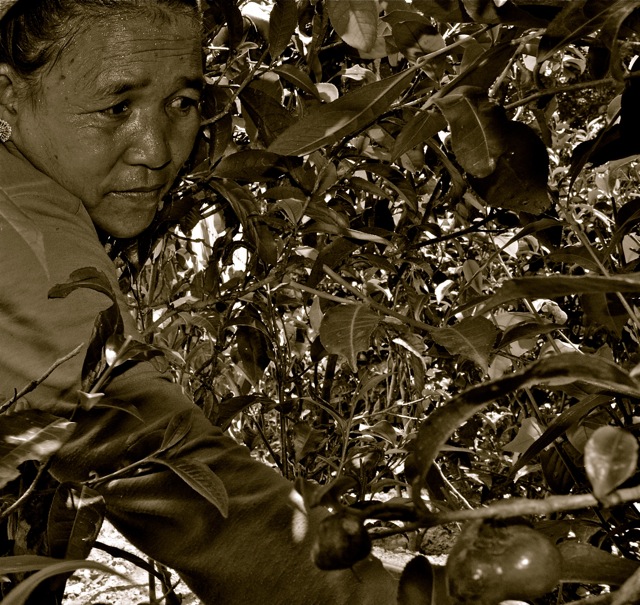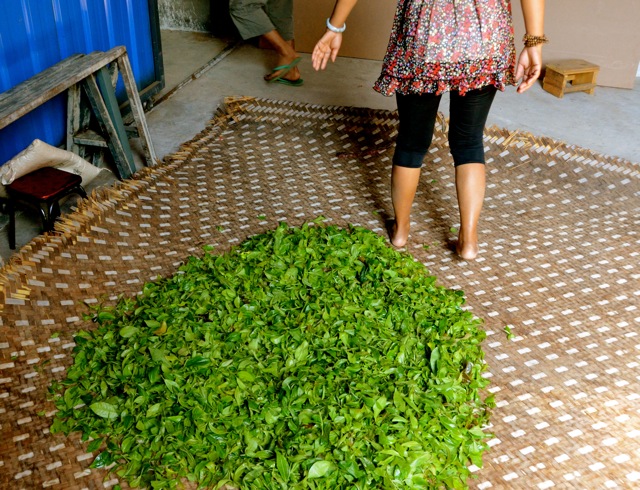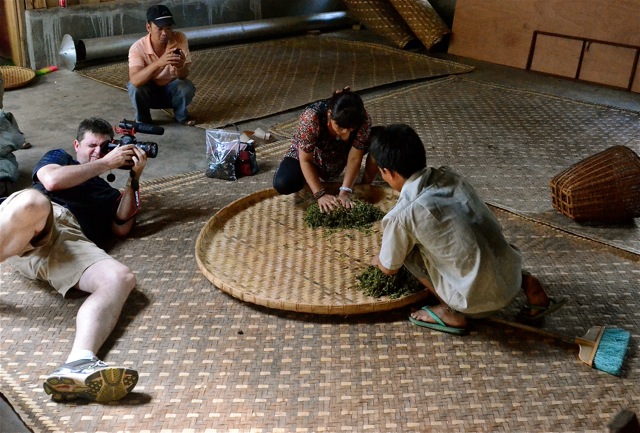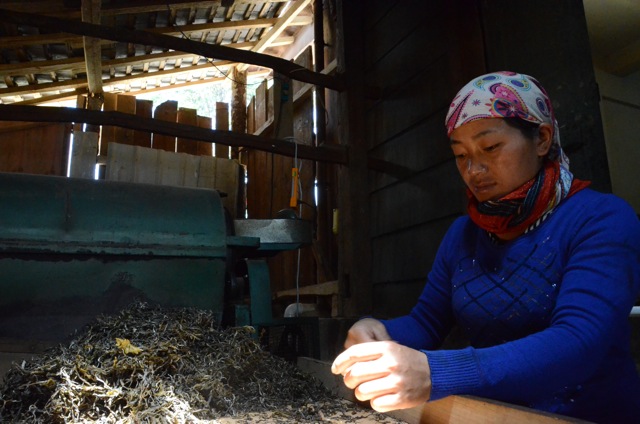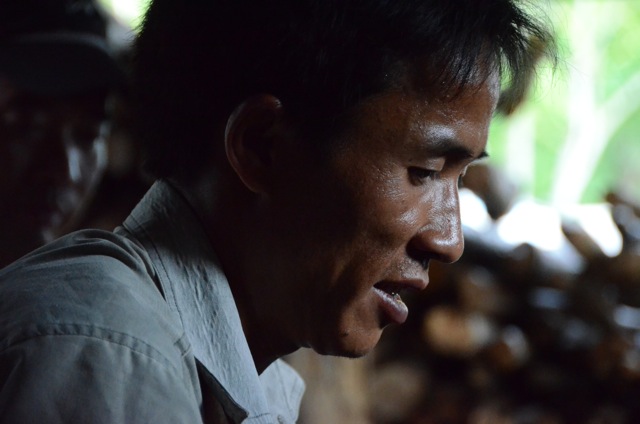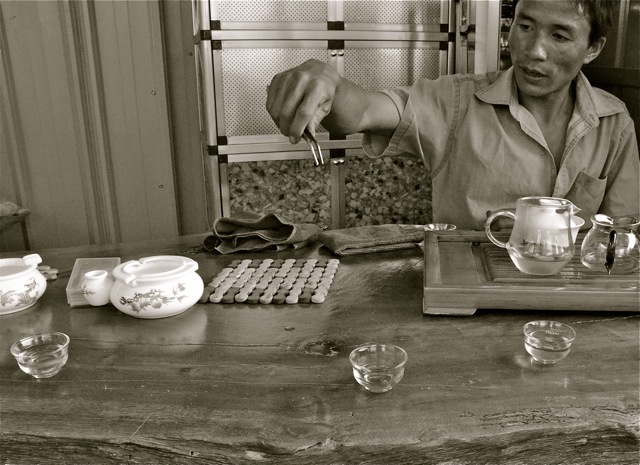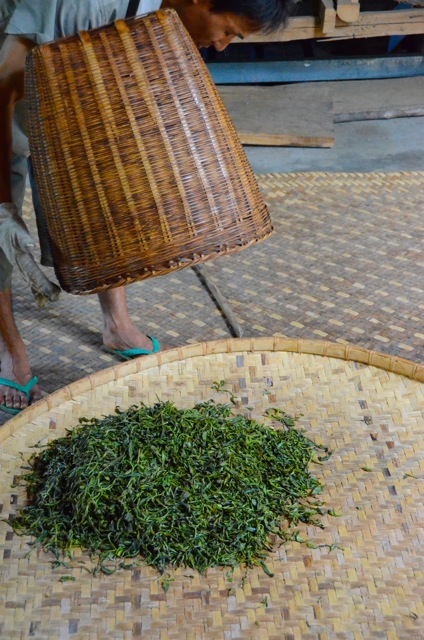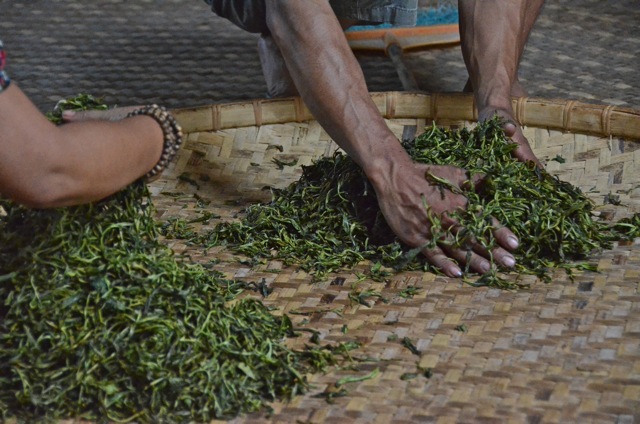The Leaves Arrive
There is something called a tea sweat, and I’m experiencing it. So is Andrew, and for someone of 250 lbs of Irish-Scotch bulk and a 6ft 7inch frame, this first time is something to enjoy, cherish, and in some small part despise. It is something that entirely takes you. It encourages with stimulant power while opening every pore of the body.
We are both ripped on Pu erh tea, and Andrew is a sopping mess of a T-shirt that is absorbing the gallons of sweat that pours out of him from every single cell. We’ve been sipping Pu erh tea for days in ever-increasing amounts. The happy part of the equation is that he is in that very wonderful tea mood that is part elation and part intensity. Nimble, wide-eyed, and curious, he shifts around looking at the precious leaves that have arrived and have just been shoved into the tea frying pans. He has long learned to cope with his bulk and is restrained in every movement he makes, making certain not to disturb the space around him. One wrong turn in this little home and he could bring much inadvertent destruction. This region’s Pu erh tea has been making its way to Andrew’s home in Canada through my urgings and now his curiosity as to where it is grown, and by whom is being revealed.
His frame makes the setting that much more special and eclectic. Small bodies – and everyone is small around him – chuckle, sip, and stare at this latest harvest of Spring tea leaves from trees that have been harvested just metres from where we stand. We are far down in Yunnan’s southwestern Bulang mountain chain that hovers between Burma and Yunnan. Here in this tea district, Spring harvests are events unto themselves. It is the home of Pu erh tea, the home of some of the oldest tea cultivars on the planet and it is home to the quiet mountain people that have long used tea for all things.
Hosted by a local Bulang family – with blood vessels roaring in expectation of successive infusions of the green – we stand in a kind of crucible of simplicity. Sub-tropical forests, mountains, spring water, and food, that is sourced from the soil upon which we stand, it is a small corner of goodness in so many ways. The one thing in particular that holds Andrew and I is tea. It is in fact the only reason we have come. Thick forests, red clay, and an altitude of 1600 metres all contribute to an ideal Pu erh tea geography.
Grown locally, produced simply, and sipped at its bitter best, it is a tea that I’ve longed to slurp down. It is always this way: expectation, and words spoken of a region or tea, a sip here and there, and then one is suddenly and nicely thrust into a particular tea’s tannins and tangs. As per normal down here in the south, there is no warning until hours before that we will actually be visiting this area. “Bring a thirst, your body, and just go with it”, seems to be the mantra of the region. Andrew and I are jammed into a car and hustled southwest out of Menghai.
This little village creates teas that by the year improve through more thorough processing and more attention to each step. This is, in my little green-veiled world, the equivalent of a paradise. Green heat, mountain mists, and people who haven’t yet forgotten how to work with the land make this region a place of generosity and stimulant joy.
The leaves that crackle within the pan are being deprived of their moisture and are sinking, but at no point do they remain immobile within the heated pan. They are churned, and shrink all the while letting off wafts of roasted green glory. Patient and muscular arms with gloved hands make sure that the leaves are rolling and never still.
After pan frying of almost 10 minutes the leaves are carted over to a well-used rattan rug where bodies hustle into position on knees to knead out what is left of the leaves’ moisture. The rattan is stained dark by years of harvests that have bled their tannins into their fibers. It is a visual testament to an enduring effort.
Andrew has been swiveling, bending, and coiling himself ever closer to the action to take in every movement making comments to me, to himself, and to the air around him. Our host gently shakes the leaves out, separating and giving them air while keeping an eye on Andrew who moves ever closer. Our host’s talon-like hands then spread the tea leaves out on rattan drying trays making sure that the leaves are evenly distributed. Sun and shade will do the rest.
First Sips And a Few More
There is a saying about tea in this little valley-ridden part of Asia that speaks to what should be felt in the mouth when sampling a harvest of Pu erh tea. “The word bitter isn’t something negative”. Here, where tea was born, a little bitterness must hit the mouth (rather than sourness which is the one great ‘ill’ flavour-wise) but dissipate into an almost sweet sensation at the back of the gums before swishing down the throat. Andrew and I are seated in this same small Bulang village waiting for our sample sips.
Andrew is seated while our lean host prepares another fiercely fresh dose of the tea that his family has created. Andrew’s tea sipping skills (and appetite) have increased to a point where he actually admits to faint cravings. Air currents come through the open space, which is a casual assortment of chairs and a tea table. This tea sampling station is utilitarian; above us a tin roof, some beams, a noisy new floor below us and little else besides tea utensils. No windows are necessary in this temperate zone. Walls are waist high and my long held view that all things consumable are best enjoyed outdoors is reaffirmed.
The tea that we sip is as fresh as a tea can possibly be and carries a kind of volatile grace. Raw force and vegetal power hit first. New teas and harvests are not gentle and they are not mean to be. They carve a trail into the mouth, and if the production process is done right they’ll ease in their assault and finish gently. Our tea does exactly this and our host knows it.
The mother of our host, who is known by all as ‘Maloh’ is a constant blur and seemingly everywhere. She runs everything and from the look of her, she has been doing it all for a very long time. When we first arrived she was harvesting leaves, then she helped fry them. Disappearing then reappearing she ordered us up to sample and sit. Now she has gone and the sips are being taken. My own curiosity for the production activity of tea is easily swayed by any opportunity for a cup. We sit perched slightly forward waiting for each successive cup, which come at wonderfully short intervals.
Around us sips are taken in quick thoughtful shots. Andrew’s relentless energy forces him at times to wander, photograph, or simply stare before returning to the table to sit and sip some more. The simplicity of the event belies the taking of a tea at its prime. Full of power, the tea will develop over days, months, and years.
Tucking back into our van that can barely contain Andrew’s frame, the day’s light softens and the smells alter in the forests around us. As things begin to ease into the night Andrew and I have a tea high that is on the ascent.

